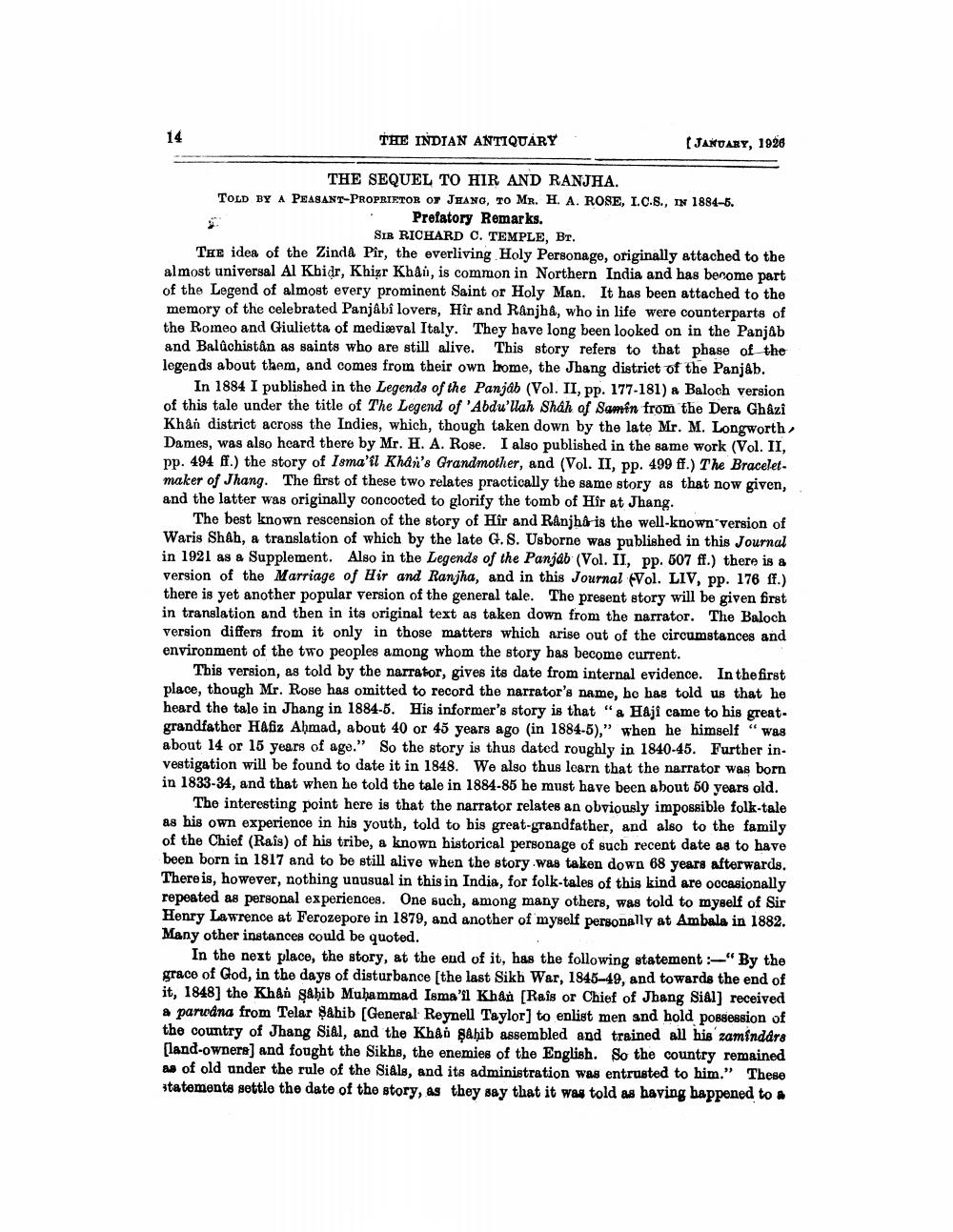________________
THE INDIAN ANTIQUARY
(JANUARY, 1926
THE SEQUEL TO HIR AND RANJHA. TOLD BY A PEASANT-PROPRIETOR OF JHANG, TO Mr. H. A. ROSE, I.C.S., IN 1884-5.
Prefatory Remarks.
SIR RICHARD C. TEMPLE, BT. The idea of the Zinda Pir, the everliving Holy Personage, originally attached to the almost universal Al Khidr, Khigr Khan, is common in Northern India and has become part of the Legend of almost every prominent Saint or Holy Man. It has been attached to the memory of the celebrated Panjabi lovers, Hîr and Ranjha, who in life were counterparts of the Romeo and Giulietta of medieval Italy. They have long been looked on in the Panjab and Balûchistan as saints who are still alive. This story refers to that phase of the legends about them, and comes from their own home, the Jhang district of the Panjab.
In 1884 I published in the Legends of the Panjab (Vol. II, pp. 177-181) a Baloch version of this tale under the title of The Legend of 'Abdu'llah Shah of Samin from the Dera Ghazi Khan district across the Indies, which, though taken down by the late Mr. M. Longworth Dames, was also heard there by Mr. H. A. Rose. I also published in the same work (Vol. II, pp. 494 ff.) the story of Isma'il Khan's Grandmother, and (Vol. II, pp. 499 ff.) The Braceletmaker of Jhang. The first of these two relates practically the same story as that now given, and the latter was originally concocted to glorify the tomb of Hir at Jhang.
The best known rescension of the story of Hîr and Ranjha is the well-known version of Waris Shah, a translation of which by the late G.S. Usborne was published in this Journal in 1921 as a Supplement. Also in the Legends of the Panjab (Vol. II, pp. 507 ff.) there is a version of the Marriage of Hir and Ranjha, and in this Journal Vol. LIV, pp. 176 ff.) there is yet another popular version of the general tale. The present story will be given first in translation and then in its original text as taken down from the narrator. The Baloch version differs from it only in those matters which arise out of the circumstances and environment of the two peoples among whom the story has become current.
This version, as told by the narrator, gives its date from internal evidence. In the first place, though Mr. Rose has omitted to record the narrator's name, be bas told us that he heard the tale in Jhang in 1884-5. His informer's story is that "a Haji came to his greatgrandfather Hafiz Ahmad, about 40 or 45 years ago in 1884-5)," when he himself “was about 14 or 15 years of age." So the story is thus dated roughly in 1840-45. Further in. vestigation will be found to date it in 1848. We also thus learn that the narrator was born in 1833-34, and that when he told the tale in 1884-85 he must have been about 50 years old.
The interesting point here is that the narrator relates an obviously impossible folk-tale as his own experience in his youth, told to his great-grandfather, and also to the family of the Chief (Rais) of his tribe, a known historical personage of such recent date as to have been born in 1817 and to be still alive when the story was taken down 68 years afterwards. There is, however, nothing unusual in this in India, for folk-tales of this kind are occasionally repeated as personal experiences. One such, among many others, was told to myself of Sir Henry Lawrence at Ferozepore in 1879, and another of myself personally at Ambala in 1882. Many other instances could be quoted.
In the next place, the story, at the end of it, has the following statement :-"By the grace of God, in the days of disturbance (the last Sikh War, 1845-49, and towards the end of it. 18481 the Khan Sahib Muhammad Isma'il Khan (Rais or Chief of Jhang Sial] received a parodna from Telar $Ahib [General Reynell Taylor) to enlist men and hold possession of the country of Jhang Sial, and the Khao Sahib assembled and trained all his zamindars [land-owners) and fought the Sikhs, the enemies of the English. So the country remained as of old under the rule of the Sials, and its administration was entrusted to him." These statements settle the date of the story, as they say that it was told as having bappened to #




